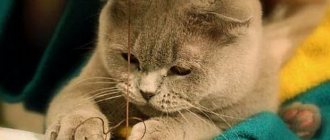To accurately understand the character of British cats, you need to watch them for some time. At first they seem very sweet and kind, but this is not entirely true. Such cats are individuals who know their own worth and have their own opinions.
British cats leave few people indifferent. Their behavior is quite complex and contradictory; one cannot draw conclusions only from the appearance of these beauties.
How to properly punish British cats?
The cat should be removed
from the table and say “No!” in a decisive intonation, such actions are quite enough for the British
cat
to understand the prohibition.
If the cat
starts to scratch, then simply hiss at it like a cat, so the animal will understand your action as: “Quickly stop!” At the crime scene.
Interesting materials:
What does the word Siri mean? What does the word smog mean? What does the word combination mean? What does the word Soulmate mean? What does the word Spesivo mean? What does the word endure mean? What does the word Tyanka mean? What does the word compass mean? What does the word fiber mean? What does the word even mean?
Why are British cats evil? (Types and causes of aggression in British cats)
Often the aggressive behavior of cats is associated with a self-defense function. Such aggression is purely reactive in nature and is a defensive reaction to anything associated with danger or pain.
There are three main types of aggression:
1. Defensive-aggressive reactions to threat i.e. aggressive behavior by another cat or person, such as when one cat is seriously threatened or attacked by another cat or when a person punishes a cat by hurting it.
2. Antisocial reactions, when a cat behaves aggressively in order to interrupt or prevent unwanted contacts with relatives or people (for example, an animal of the same color causes aggression in the cat due to a negative experience of communicating with another cat of the same color in the past. Or a certain person is associated with pain and also causes fear).
3. Aggressive reactions in situations of competition, when, for example, one cat hisses threateningly at another, in connection with some of its actions.
Active cat aggression
Aggression can also be more active or offensive in nature. In such cases, the cat initiates aggressive confrontations with another cat or person who is not a threat to it. These are attacks during play (often found in young cats). Aggression during play is also a source of so-called instrumental aggression, i.e. aggression as a means to achieve a goal.
Active aggression, unprovoked, and sometimes violent attacks seem to indicate a zero tolerance for the presence of another cat. This type of aggression is observed mainly when a cat attacks a new cat that has recently appeared in the house, or a cat that previously showed aggression, but lost its position due to certain reasons. The main function of aggression in such situations is to expel the object of aggression. Therefore, these forms of aggression are designated as territorial aggression.
Aggression between cats living in the same house
Every owner knows that a scared cat can be very dangerous. This extreme state of fear is easy to identify: the pupils are dilated, the ears are flattened, the cat presses itself to the floor, retracting its head and tucking its paws, and begins to hiss and growl. Its readiness to attack is demonstrated by its flattened ears, dilated pupils, arched back and raised fur. The object of such defensive aggression may be another cat, dog or person. The cat, being an initially non-conflict creature, attacks only when an object that inspires fear comes too close to it.
Defensive aggression caused by fear and directed at people is rare, most often in cases of treating a fearful cat (treating a wound, giving medication, etc.). The cat, in this case, must be left alone until it calms down.
Event that caused fear
A sudden manifestation of dangerous aggression between two cats that previously got along well with each other is often explained by some unusual event that caused fear (association), for example, a noisy fall of an object, a slam of a door, etc., which the scared cat associates with aggression from another cat.
Conditioned reflex aggression
Mutual threats and fighting in general tend to increase fear in both cats and thus also lead to an escalation of fear-based aggression. The best measure to correct this problem is to eliminate problematic situations.
Some owners assume that cats are fighting in a struggle for leadership and, if you do not interfere with the fight, the problem will solve itself. This opinion is erroneous, because in these cases it is the prevention of any clashes and mutual threats that is decisive for the successful prevention of the problem. Feeding cats together and especially playing with them frequently will help reduce fear, as it is incompatible with eating and playing.
In particularly severe cases, one of the cats is placed in a cage for several hours every day, while the other gets the opportunity to move freely around the apartment, getting used to it and not feeling fear.
Another method can give results: cats are placed in two cages standing next to each other for several hours every day. This method is used for a long time, eventually, the fear reactions weaken, and the cats gradually learn to eat, live, play, etc., in the presence of each other without fear.
If the problem is not just a temporary phenomenon of clashes and mutual threats, it is advisable to keep cats separately.
Aggression to a negative stimulus; defensive aggression
The basis of a cat's protective behavior is not necessarily conditioned reflex fear. Even a balanced, affectionate cat can display defensive aggression in response to a negative stimulus. How else can you react to a tail pressed by a door, a heel on a paw and other horrors of living together?!!
In this case, pain may prompt the cat to react defensively. She will put out her claws or start biting. This should be remembered when young children, unsupervised by adults, are attacked by a cat while playing. For the same reason, a bite from one angry cat can cause an aggressive reaction in another cat.
There are also frequent cases of aggression caused by stroking for too long, which is unpleasant for the cat. Different cats have different attitudes towards stroking with their hands: some of them are vitally important, and they are ready to lie on their owner’s lap for hours, others tolerate it depending on their mood, patience is exhausted, cats bite the hand and jump to the floor to run away. As they say, nothing personal. These are purely individual preferences and therefore it is necessary to avoid actions that cause a negative reaction from the cat.
To do this, you need to be able to recognize signs that indicate irritation (for example, tail movement, restlessness, pinned ears).
Territorial aggression
Territorial aggression differs from defensive aggression in that the actions of the aggressor are determined not by fear, but by completely different motives. At any opportunity, a terrorist boldly pursues his opponent and attacks him.
In the case of classic territorial aggression, the aggressor does not show the slightest sign of fear before the attack and, more often than not, persistently seeks confrontation, using every opportunity to attack. This is how a new animal can be welcomed into the house. This problem usually appears between one and three years of age and can also occur in cats that previously got along well with each other.
Sometimes cats, without showing fear, attack house guests. This is an example of active aggression directed at people, which suggests some kind of defensive motivation underlying this behavior.
If, when correcting the classic form of territorial aggression (where one cat fearlessly, constantly stalks, chases and attacks an extremely fearful victim), all measures taken have not achieved results, the only reasonable solution will be to find a new owner for one of the cats.
Aggression between cats
Aggression between cats can be considered a form of active or territorial aggression. In the wild or in conditions of partial freedom, cats quite clearly demonstrate territorial behavior, often reacting aggressively to each other. When two unfamiliar cats meet, they may demonstrate ritualistic threatening postures and movements.
Their body is like a stretched bowstring, they stand opposite each other on outstretched legs, without taking their eyes off each other. At the same time, their ears are pressed back and turned back. They shake their heads, purr and, grinning, open their mouths. If one of them stops threatening the other and begins to slowly retreat, the fight may not take place.
If several conflicting cats live in the same house, you can try to apply the behavior correction methods already discussed above (for forms of defensive aggression) to them. If this does not bring a positive result, the owner can only give away one of the cats, or castrate them both. In most cases, as a result of castration, their aggression disappears, or at least weakens, in the absence of a reason for the dispute. However, their mutual intolerance may be much deeper. In this case, castration does not solve the problem. Therefore, if aggressive behavior does not stop, then no behavior correction measures will help. In this case, owners can be advised to keep only one animal in the house.
Pathophysiological aggression
Aggression in cats can be triggered by a number of pathophysiological diseases: trauma, infection, parasites, rabies, arthritis, blocked anal glands, painful lesions of the skin around the mouth, tumors, toxins and feline ischemic encephalopathy, etc. As a result of the uncomfortable state, the sick cat becomes irritable and displays defensive aggression.
Idiopathic aggression
In this case, the cat attacks family members without any apparent reason. Such aggression does not fit into any of the usual schemes of defensive or active aggression, but carried out in vet. hospital examination excludes the presence of pathophysiological disorders. In the specialized literature, such attacks, caused by unknown reasons, are called idiopathic aggression.
Rough games
If the only cat in the house is left alone for a long time, then due to its unspent energy, one can observe an excessively high playfulness of the animal. Attacks on owners during play indicate a lack of communication.
The same problems arise from rough and improper games with a cat. They can also cause the cat to attack family members, encouraging it to behave aggressively.
As a distracting maneuver, inexperienced caregivers sometimes throw toys at the cat, which only encourages the animal to continue playing and increases its desire to attack its owner. In this case, you should persistently and consistently stop such cat games in every possible way.
War with the aggressor
For any attack, the cat must be punished immediately. For example, she can be strongly scolded, sprayed with water from a water pistol or sprayer, or scared with a loud sound (clapping hands, rattles, etc.).
The distracting stimulus must be strong enough to stop the aggression instantly. At the same time, the punishment should not be too severe, otherwise the cat, frightened, will hide and remain in ambush for a long time.
For aggressive behavior, the cat should be punished immediately after the attack (i.e. within 1-2 seconds).
A very active and playful cat needs to move more, which will weaken its desire to attack its owner.
When a cat is left alone, it must have toys at its disposal that it loves to play with.
The best thing you can do to keep your cat from getting bored and to have the opportunity to express its energy is to get a few more cats!
To meet the cat's play and exercise needs, it is very helpful for the owner to set aside time for daily play with the cat.
Instrumental behavior
Sometimes cats use aggression as a kind of tool (cats use it as a tool or strategy in their pursuit of a goal).
Problems associated with begging, intrusiveness and the cat's desire to attract attention sometimes become a disaster. For example, the owner has to wake up at night and satisfy the desires of his cat. Feed her or play with her until she calms down and allows him to fall asleep. The lack of a desired reward can cause her to react negatively (for example, demanding meows).
To stop any unwanted forms of cat behavior, you need to once and for all determine for yourself who is intended for whom. The cat is for you or you are for her. And based on the decision made, build further relationships. In all cases, your coexistence should be built on mutual respect.
At the same time, having banned something once, you should continue to be consistent in your actions. Only then will the cat learn the futility of its excessive claims. You should not change your positions until the cat's behavior is completely corrected.
Recommended
For example, to correct the frequently recurring form of instrumental behavior of a cat that constantly wakes up its owner in the middle of the night, choosing him as an indispensable participant in its games, you should try the following actions:
Leave it outside the bedroom door at night.
Under no circumstances should you open the door for her, even if she meows and tries to knock down the door.
Do not respond to the cat's complaints. (Don't talk to her or make any noise).
Most likely, during the first few nights, the cat will experience severe stress due to being expelled from the bedroom, and its behavior will worsen even more. This is fine. You just need to show more persistence than she did, and sooner or later your tormentor will calm down her claims.
After a few quiet nights, you may unthinkingly relax, imagining that your invader has finally given up trying to spend the night with you. It's an illusion! As soon as he gets into the coveted room, everything will start all over again.
In fact, the creature you abandoned will continue to try to impose its company on you for a long time, sneaking into the bedroom. Be strong! The main thing in this situation is never to give in, and then attempts will be repeated less and less over time and will stop completely when the cat is finally convinced of the futility of its intentions. However, hope dies last.
5 / 5 ( 1 voice )
Your pet is shedding - it doesn't hurt to be careful
In addition to the reasons already mentioned that provoke molting in a cat, more serious events may also occur.
Most often, owners pay attention to off-season shedding in winter, immediately starting to worry.
However, in most cases there is no reason for this, since in winter a British cat receives less vitamins, warmth and care. This is what causes the British cat to begin to actively shed.
In addition, you can name several more reasons when a pet sheds:
- stressful situations: in most cases this is associated with moving, undergoing operations or long-term illnesses;
- childbirth: in addition to the fact that the pregnancy process itself takes away strength, babies take almost all the nutrients from the mother, as a result of which she begins to shed;
- poor nutrition: cats react very sensitively to the slightest changes in their tiny bodies, so a healthy diet is very important;
- allergic reactions: most often occurs due to the British intolerance to certain types of dry food;
- hormonal surges: especially noticeable in breastfeeding women after childbirth;
- the presence of fungi and diseases.
Rules of education
The British cat breed begins to develop character at the age of one to one and a half years, but the habits of animals are developed at any time, so education plays a big role in the life of cats. The taming process is sometimes difficult, and not all owners understand how to raise a pet.
- From a very early age, kittens should be taught to use a litter box and to be clean. This will not be a problem if the babies grow up with their mother, as they often repeat the actions of adult cats.
- Try to accustom your cat to being handled, but due to the characteristics of the breed, this is difficult. Perhaps you can create affection in the cat or make the cat affectionate.
- We do not recommend raising cats very strictly, but they must understand the difference between a pet and an owner. The British must have a certain place to sharpen their claws. Teach your animal to always eat only from a bowl and do not give food from your table.
- Don't hit or scream at the British. Representatives of this breed do not understand this behavior. Instead, let him know in a stern voice that he can’t do that.
- Don't forget about praise. Give the cat some goodies, encourage correct behavior, show your care and sympathy.
- The best time to spay a cat is between six and nine months of age. After sterilization she will become calmer and lazier.
Bad habits
Like any other cats, cats of the British breed have their own bad habits and habits.
Cats love to drop objects. In such a situation, you need to immediately prohibit your four-legged friend from behaving this way. Try treating the surface with something. Rest assured that after the first punishment the Briton will realize his mistake.
Sometimes kittens may start scratching and biting. In adult cats, this habit usually disappears. If it remains, you should buy various pet toys at the pet store with which the kitten can have fun and thereby get rid of the habit.
Some cats love to inspect the contents of many people's bags and packages. They are unlikely to harm things, so you shouldn’t stop this habit.
Origin of the shorthaired breed
As you might guess, the British straight-eared cat first became known on British territory. Those interested in it often have questions about the age of the breed. The fact is that no one had previously been particularly involved in describing the origin of breeds. Stud book records arose much later. To illustrate this statement, it is enough to say that the breed received a standard and pedigree only at the very end of the century before last, namely in 1898.
However, there is some information about when to start counting the breed. Researchers suggest, and not without reason, that the age of this wonderful breed is similar to the age of the Roman Empire! Where did such information about the origin come from if there were no stud books? It's time to turn to ancient images of that period. On them you can see cats that are strikingly similar to modern representatives of the British breed.
IMPORTANT: By the way, initially this cat was short-haired.
It is possible that it was precisely this short, tightly knit coat that the breed reached such an impressive age. The cat was given the opportunity to survive in any conditions. In addition, the cover helped the ancient representatives of the breed to always look quite representative. The gray color of the plush fur is exactly the universal color that most owners like.
In addition to the color and texture of the coat, the breed attracted such characteristics as endurance and enviable physical strength. The British cat is developed, has a massive back and shoulders. Quite muscular legs can also be considered a feature. As a result, the weight of representatives of the breed is rather large - from 5 to 8 kg with a height of 9-14 cm. What is unique is that with such height and weight, the breed managed to look quite harmonious and move gracefully.
It is quite natural that such a hardy, physically developed cat found a place among Roman sailors. They gladly took animals with them - this is how it was around the 2nd century BC. The breed appeared on British lands. Graceful animals with a mysterious gray color immediately fell in love with local residents. This color is also called blue. Even today it is very popular, and many centuries ago, according to surviving information, it was the only option.
In many ways, the age of the short-haired breed is so impressive because its representatives brought by the Romans crossed not only with each other, but also with wild cats. Given the isolation of the area, the breed concentrated on the islands, acquiring resistance to the legendary British rainy and windy climate. Which, of course, is a huge advantage when kept in our latitudes.
Basic character traits
Let's talk about the main character traits that the breed actually demonstrates:
- Independence is a characteristic that has given rise to some of the myths described above. Despite the fact that in reality the Briton is very attached to his owners and loves to communicate with them, he is extremely proud. You could say he has a truly British sense of dignity.
- No way in the world would he show weakness. By the way, this is a huge plus, since regardless of age, the cat is unlikely to behave inappropriately - for example, ruin the owners’ shoes or wallpaper.
- Patience - thanks to this character advantage, a cat can easily get along with other pets and people. The Briton will not become violently offended over trifles, which makes him quite accommodating. But, of course, such behavior extends only to the limits of reason - if necessary, an aristocrat can fight back.
- Curiosity - age is not a limiter in this regard. Both kittens and adult animals enjoy exploring the world. By the way, with this feature it is very easy to find a common language with your pet. If you constantly communicate with him, of course.
- Friendliness - the breed is unique in that, unlike most representatives of the cat family, it is not inclined to single out one owner. She is equally friendly to everyone . Even to guests.
- Intelligence - the short-haired aristocrat will always understand what is required of him. Whether he will fulfill it is another question, but he will always understand.
- Excellent Parent – British people are widely described as making excellent parents. It is believed that before the baby reaches 4 months, it is impossible to separate him from his mother. It will be equally painful for both. British women usually make very sensitive, caring mothers, and their offspring make obedient children.











